State of the art - on irrigation farms - Edition 1
| Who: Craig Reynolds
Where: Congupna East Enterprise: Cropping What: Soil Moisture Monitoring | State of the art - on irrigation farms - Edition 1 (PDF 644 KB) State of the art - on irrigation farms - Edition 1 (DOC 126 KB) To view the information PDF requires the use of a PDF reader. This can be installed for free from the Adobe website (external link). |
| On the Farm
Background Craig and Helen Reynolds work an irrigated cropping farm of 570 hectares at Congupna East, growing both summer and winter crops on a Controlled Traffic Farming (CTF) system. They have used soil moisture monitoring (SMM) equipment with a shaftal clover crop in April 2009 intended for silage/hay, then locked up for seed production. The SMM probe was moved and used for a quick season maize crop at the end of 2009. Craig’s expectations – prior to installation of SMM equipmentBy using SMM technology Craig expected to get an idea of the moisture content in the soil at different depths, and the water holding capacity of his soil. He planned to use this information to determine the correct time to refill the profile, allowing him to schedule irrigations more efficiently. Craig also hoped to discover where in the soil profile moisture existed, and how much of the soil profile is used by the crop at different stages of crop growth. Craig was also interested to know how far water penetrates into the soil profile after irrigation events. He hoped to see how much water stayed in the rootzone after irrigations, which range from 0.5 to 1.0 ML/ha per irrigation, depending on the season. “If the technology shows water penetrates to 50 cm and the crop uses all of that, then I am happy – no leakage and confirming the irrigation is efficient.” | 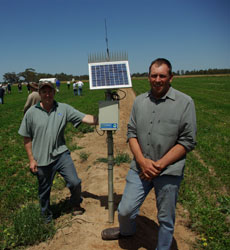 Craig near his Soil Moisture Monitoring System |
The device used on this site
Craig uses an Enviropro unit – a sealed, vertical capacitance probe that measures soil moisture, soil temperature and electrical conductivity (EC) at 10 cm increments to a depth of 80 cm. The sealed sensor can be installed below ground level, making it less prone to damage from stock and machinery. The probe is connected via an underground cable to a data logger positioned on a checkbank, with a sensor interface board, solar panel and a GSM modem that sends the monitoring data via the mobile phone network to a server for storage. Data can be retrieved over the internet by Craig using his farm computer.
The benefits according to Craig
“I have been amazed how much has been grown this year without irrigation. I was able to maximise the effect of rainfall and take advantage of that. I could look at the data and forecast the likely day I would need to irrigate. I would then look at the weather forecast and estimate if the crop was going to make it to the forecast rain event without limiting production. If it looked like there was enough moisture in the soil to get there, I would hold-off irrigating and maximise the rain event. If it looked like it wouldn’t make it, I could choose to irrigate earlier and then still take advantage of the rainfall event. The worst thing that can happen is rain close to irrigation because the crop gets too wet. I was able to avoid this situation.”
“The first and last irrigations are the most important to my winter cropping operations. Having the soil moisture data allowed me to time these irrigations to maximise the effect on the crop. I could see what level of moisture was available to the crop and make a decision to irrigate or not. Without the data I would just irrigate because I wasn’t sure. The data has shown that the first irrigation may not always be needed because there is enough moisture in the soil. In addition, it might be possible to eliminate pre-watering using the SMM data, which would be a huge benefit.”
“There is more and more to manage, and the data makes it easier to do. Having the soil moisture data means I don’t have to be checking the situation in the field as often, saving time and helping eliminate uncertainty. The data gives me confidence to make the call because I can see what’s happening below the surface.”
“Having the probe has allowed me to identify my site specific characteristics. For example, initially we expected to push the interval between irrigations out as far as possible to reduce waterlogging, assuming that flood irrigation can cause waterlogging. The data did not show this at my place – waterlogging after irrigation was limited. We did not see the plant shut down due to waterlogging, which is what would be expected in a flood irrigation situation. It also gives me insight into how the soil performs, how much water can be held in the soil, how well the crop utilises the soil water and where it uses it from.”
When is the paddock ready to be irrigated again after rainfall? “The data lets you know when to start irrigating again – when the soil profile has dried out to the point where irrigation is needed.”
It may be possible for Craig to take advantage of the more consistent and higher flow rates possible after modernisation of the irrigation delivery system. In Craig’s situation it could be beneficial to vary the irrigation flow rate onto bays, based on the crop stage. In the early stages of growth. it might be better to push higher flows across and reduce the depth of the irrigation. Alternatively, when the crop is more mature and the deficit higher, the irrigation might need to be slowed down. Soil profile moisture data can provide Craig with the information needed to fine tune this strategy.
“There were also unexpected benefits, for example the soil temperature option provided by the probe allowed me to hold off sowing this year. Other people I know without this data sowed to date and their crops were affected by the cold. I sowed when the temperature was right.”
“There is significant potential to get more out of it as my knowledge increases about what the data is showing.”
| How much did it cost?
Craig’s site cost $3,840 to set up in April 2009, which included the probe, logger, solar panel, cabling, graphing and logging software, and installation. Ongoing costs are around $30 per month for a SIM card, required for transferring the data from the probe logger, and for hosting and managing the data on the service provider’s internet server. There are a number of ways systems can be configured, including GSM modem, radio telemetry and cable. In general, a user would pay more for greater convenience, reliability and service. For example, with a radio telemetry option there are lower ongoing costs because no SIM card is required, and the data is hosted on the farmer’s own computer. However, this would require management of downloads and data. Cable options are generally cheaper still, but usually require someone to physically connect a cable to the logger in the field each time the farmer wants to check the data. | 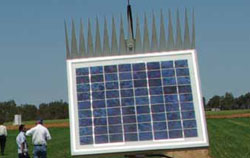 Soil panel unit for SMM data logger |
Did the benefits outweigh the cost?
“Yes — gut feel says it does but it’s hard to quantify.”
“Quantifying the benefits of this type of equipment is a bit like trying to quantify the benefits of GPS in cropping systems. There are heaps of small benefits that add up to big benefits but they are individually hard to measure. The question should be, “could I work without the data now?” and the answer would be no — this confirms that the benefits outweigh the costs. In fact, I plan on buying two more systems to provide more data.”
Is there anything to look out for?
“Go for a below surface probe so you don’t have to hand sow and cut around the probe. Below surface probes can be worked over just like the rest of the paddock, so there are fewer issues with it being representative of the whole paddock.”
“Make sure you’re happy with the software to display the data before you purchase. The type I use is really easy to read and use but I’ve seen others that are confusing and difficult to understand.”
“Make sure the supplier provides a good training package so when they’ve gone and you’re left to use it you know what you’re doing and get the benefits.”
“Ground truth the data. Calibrate what the probe is showing you by digging in the field to ensure it’s accurate and you know what the level of moisture displayed on the screen translates to in the field. Every time I did this the data was accurate, providing confidence I could rely on the data for decision making.”
Are there any other examples we know about?
Yes – the DPI/NVIRP demonstration project involves the following participants:
Dairy — Jade Clymo, Chris Hunter, Ross Nicoll, Paul Gill, Brendan Martin, Brett Dixon, Steve Hore.
Cropping — Malcolm Pendlebury, Brett and Colin Radcliffe.
Tomatoes — Mark Hill.
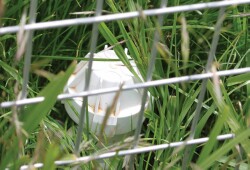 SMM capacitance probe cover | Research
Broadly, there are two ways to improve irrigation scheduling decisions using objective data. One involves estimating or measuring crop evapotranspiration. The other involves estimating or measuring how much soil moisture is available for the crop. Both approaches have strengths and weaknesses. Systems based on crop evapotranspiration are being increasingly used in precision irrigation applications such as drip irrigation of horticultural crops. Here, the irrigation can be continuously varied to meet the crop demand. In one such system, DPI researchers have been collaborating with the CSIRO to trial an application that uses satellite images to measure the canopy cover of individual crops. This is used to estimate the crop coefficient for each crop. Data from local weather stations is then used to estimate the water use of each crop, and the actual pump run time required to replenish soil moisture is sent to irrigators by SMS. irriGATEWAY (external link). |
Soil moisture monitoring – installation issues
In the case of soil moisture monitoring with capacitance probes, there are a couple of issues users need to be aware of. One is the need for good contact between the probe and the soil. Meter installation must be carried out with great care because small air voids adjacent to the probe casing will produce misleading data. Another issue arises because of the very small volume of soil actually sampled by the probe. The probe may be working perfectly, but if the tiny volume sampled is not representative of soil properties across the paddock, or if it is sited at a relatively wet or relatively dry spot in the paddock, the data will be misleading.
As Craig says, it is important to ‘ground truth’ the instrument in the field to give you the confidence it is working well.
| Soil water content
The timing of irrigations should be based upon soil moisture content and the crop water requirement. Knowing the status of soil moisture in the crop rootzone is a great advantage and allows more confident decision making. The value of measuring soil moisture can be greatest following periods of rainfall, when it can be hard to estimate the available soil water and crop water demand. It is always difficult to time the last irrigation in autumn and the first one in spring – knowing the soil moisture status at these times can help greatly with the timing of irrigations. Soil temperature It is good practice to sow summer crops on the basis of soil temperature. It also helps with understanding what is happening to a range of other crops throughout the year. | 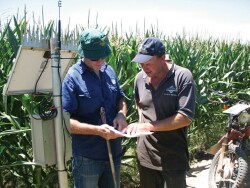 MAIT Australia representative Adrian Orloff disucss SMM data with irrigator Craig Reynolds |
Making use of the data
Getting easy access to the data, in a format you can interpret, is a key to getting the best value out of any monitoring equipment.
Soil moisture monitoring systems cannot substitute for careful observation of the crop, but they do provide important additional information about what is going on below the soil surface. Although he is an experienced irrigator, Craig is continuing to learn a lot about irrigating his soils by using soil moisture monitoring equipment. He has a better idea of how effective his irrigations are, and he can schedule irrigations when he knows soil moisture is depleted. The equipment is providing him with additional information upon which to base his decisions, and at the same time, has challenged some of his previous assumptions, improved his management skills and increased productivity.
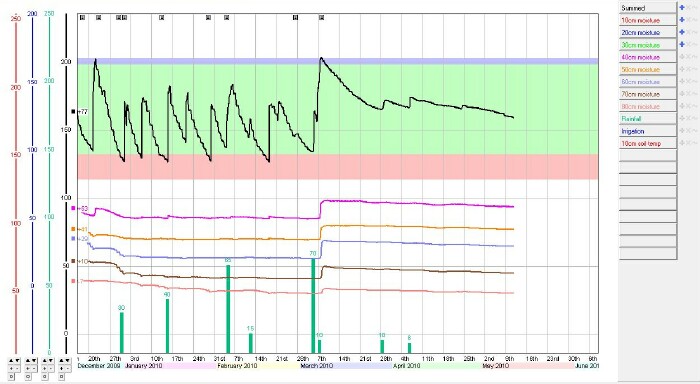
Further information
- Talk to Dale Boyd at DPI Echuca on 03 5482 1922
- Information notes - Go to www.dpi.vic.gov.au
| Name | Company | Mobile | |
| Adrian Orloff | Mait Australia | 0438 655 350 | adrian.orloff@mait.com.au |
| Graham Webb | G&M Poly Irrigation | 0407 534 223 | graham@gmpoly.com.a |
| Peter Moller | Rubicon | 0418 953 999 | matthew.collins@rubicon.com.au |
| Charles du Bourg | IK Caldwell | 0428 210 477 | charlesd@ikc.com.au |
| Graeme Wright | WISA | 0427 036 520 | graeme@irrigatewisa.com.au |
| Joe Hoogland | MEA | (08) 8332 9044 | mea@mea.com.au |
| Paul Andrews | Sentek Australia | 0407 400 699 | pandrews@sentek.com.au |
| Paul Hudson | Cropsol | 0428 468 674 | paulhudson@cropsol.com.au |
| Sam Birrell | Netafim | 0418 311 157 | sbirrell@netafim.com.au |
| Scott Muller | H-R Products | 0417 054 475 | hrcobram@bigpond.com |
| Malcolm Frick | John Deere Water | 0427 053 479 | mfrick@tsystems.com.au |
..................................................................................... |
Pipes and Risers
Who: Brad and Leesa Windrige
Where: Leitchville
Enterprise: Dairy
What: Pipes and Risers
On the farm
Background
Brad and Leesa are currently milking 280 cows on their 115 hectare farm, 3 kilometres west of Leitchville. They purchased the farm in 2005, and moved from a smaller family farm close by. The property has predominately grown annual pastures over recent years, with some summer cropping. Approximately 55% of the property is Una Loam (Group 2 soil), 15% Cohuna Fine Sandy Loam (Group 1), with the balance comprising of Reedy Creek Loam (20%) and Koroop Clay (10%). Annual water use has been around 400 ML in recent dry years, with the aim of applying 400-600 ML when water availability becomes ‘normal’.
Drought conditions have driven Brad and Leesa to consider more efficient ways to apply water. The family had experience with pipe and riser systems on another property, and decided to install a similar system on this farm. The first stage resulted in 300 metres of pipe and riser system being installed, and they have continued to add to it ever since.
The benefits according to Brad
Once the first section of the farm had pipe and risers installed, Brad saw benefits in addition to water savings, particularly relating to the ease of managing irrigations. This coincided with a dry season which heightened the importance of the water saving benefit provided by the system. These factors motivated Brad to make further investments in pipe and risers.
The pipe and riser system gives Brad much greater control over irrigations. He can irrigate bays individually, rather than having to irrigate the set of bays commanded by an open channel, as was the case under a gravity system. Irrigation flow rates are consistent across the farm, and are higher than measured previously, getting water on and off the bays more quickly.
Brad can now instantly irrigate the furthest bay from the irrigation supply point without having to fill long sections of farm channel, which previously took 12 hours to fill. Water losses from these farm channels, caused by seepage and evaporation, would have been significant – particularly during periods of low water allocation, when channels often dried out between irregular irrigations.
“I can now take water to the furthest point (or anywhere in between) instantly with the press of a button.”
“With the old system I’d have to open four bays at a time to get around the irrigation set, and it would take around 12 hours to irrigate the four bays. These bays should ideally be irrigated in four hours so there has to be an efficiency gain by not having small flows on for long periods of time – deep drainage would be reduced.”
“It’s hard to gauge the production benefits because of the variable seasonal conditions since I’ve had the system installed. I can irrigate straight after grazing, whereas previously I’d have to wait for 4 bays to be grazed before irrigating that set of bays. I grow a lot of annuals but I’m also growing 20 ha of sorghum, 10 ha of lucerne and 10 ha of maize – all under pipe and risers. I probably wouldn’t be confident growing these crops without the system (or at least get the production we are). I plan to grow more maize next year and more lucerne in autumn.”
Benefits – ease of managing irrigations. Now Brad can:
|
Brad believes he is more efficiently using water and has realised about 25% in water saving over the old system. This is difficult to reliably quantify because the development has been done in stages over a period of unusual climatic conditions.
“I have an application into the Farm Water Program for further development to include direct suction from the supply channel and looping the system to pick up the bays that are not currently under pipe and riser. With the expanded system the entire farm will be done, which will be a big benefit in terms of managing irrigations.”
“The Farm Water Program requires me to provide some of the water savings to the Federal Government, but I expect to pick up a fair percentage of that water through reduced water losses, greater irrigation efficiency and improved production with the new system.”“I would like to automate down the track, which would make it even easier and almost eliminate the labour and time involved in irrigating.”
How much did it cost?
“A rough estimate would be $60 per metre, and I have 1.4 kilometres done so that’s about $85,000 for what’s done so far. I’ve been able to progressively develop the system, so the financial impact has been less.”
Did the benefits outweigh the cost?
“I was making the change during the height of the drought when water was worth a fair bit, so it was cost effective from that perspective – I could justify the cost through water savings and was able to irrigate at the time even though water was expensive. I grew good feed (30 acres of lucerne) and started up annual pasture earlier than I would otherwise have been able to.”
“Grants are available now and taking advantage of these would make it much more cost effective.”
“I could not farm the place the way it was (without the pipeline) due to its inefficiencies (water and labour), so all I can say is for my situation it was worth it.”
Is there anything to look out for?
“Do a Whole Farm Plan when designing the system so you set out the farm properly. It limits the risk of getting into the development and something going wrong or not lining up with your plans.”
“Maximise the flow rate – try and get the greatest flow rate you can for the budget you have.”
Research
Historically, DPI has done little research into on-farm irrigation infrastructure, and no research on pipe and riser systems, so these comments are necessarily general.
The previous water distribution system on Brad and Leesa’s farm was inefficient, difficult to manage and required redevelopment, so it was an appropriate time to consider a pipe and riser solution. On a farm with an efficient surface distribution infrastructure, the benefits of conversion to pipe and riser would not be as significant.
The benefits of conversion to a pipe and riser system on this farm include:
- Much more efficient conveyance of water within the farm, with minimal water losses. Water savings would be achieved by reduced on-farm deep drainage and seepage, and reduced evaporation losses.
- The pipe and riser system allows Brad to irrigate with higher flow rates, which on his relatively light soils would be important for minimising deep drainage losses, particularly during establishment of annuals when crop water demand is low and root systems have limited capacity to use water infiltrating to depth in the soil profile. The new system also gives Brad greater control over irrigations and a consistent irrigation flow rate, reducing risk when irrigating crops such as lucerne and maize.
- Faster surface irrigation also reduces evaporation losses during the irrigation event.
- As well as water savings, a major improvement is in the operational flexibility the new system provides, allowing Brad to manage the irrigation of each bay independently, rather than having to irrigate sets of bays at a time. Irrigations can now align more closely with his grazing management, and with pasture or crop water requirements.
- The new system is operationally much more efficient, significantly reducing his labour costs and demands on his time. As Brad has indicated, these systems are also well suited to automation, the cost of which may be offset by further reducing his labour costs, and by being able to make greater use of off-peak tariff electricity.
- Benefits of pipe and riser systems that Brad hasn’t mentioned include the freeing up of land previously occupied by the water distribution infrastructure (which can be a surprising proportion of the area of some farms), improvement of access within the farm once open channels have been removed, and elimination of channel maintenance costs.
- The establishment cost of pipe and riser systems is significant. These systems can be developed in stages as Brad has done, which doesn’t reduce the cost – and may in fact increase it – but does reduce risk, and may make financing easier. Brad highlighted the value of a Whole Farm Plan that takes the staged development of the farm into account.
- A factor to bear in mind is, unlike gravity systems, pipe and riser systems require water to be pumped, meaning greater exposure to increasing energy costs and the potential impacts arising from new policies on greenhouse gas emissions in the future.
Further information
- Talk to Kathy Long at DPI Echuca on 03 5482 1922.
- Information notes – go to www.dpi.vic.gov.au
- Talk to a pipe and riser supplier or an irrigation surveyor and designer for some suggested contacts.
- Talk to other farmers that have implemented this change in your local area.
..................................................................................... |
Higher Flow Rate Irrigation - Light Soil
Who: Mark and Monique Bryant
Where: Kaarimba
Enterprise: Dairy
What: Larger Flow Rate Bay Outlets
On the farm
Background
Mark and Monique are currently milking 240 cows on their 130 hectare farm, north of Kaarimba, southeast of Nathalia. They purchased the farm three years ago from Mark’s father who had been farming the property since 1982. Mark had worked on the property for 11 years prior to purchasing the farm. The property has historically been a dairy enterprise.
The property is predominately sown to annual pasture varieties, with some cereal crops grown as well. This season, the Bryants have planted maize for the first time to utilise available water. The property is 90% East Shepparton fine sandy loam.
Irrigation supply is pumped (electric) from the Broken Creek. The recent low irrigation water allocations have meant only half the property has been irrigated. The irrigation infrastructure has also historically limited the amount of water used on the property. The Bryants would ideally aim to use 1 ML/year of irrigation water, per cow.
Low water allocations have driven them to consider ways to reduce their water use whilst maintaining or improving production. Larger irrigation flow rates have recently been promoted as an option for reducing water use, and they have installed larger outlets as a result.
Depending on the water level in the creek, the Bryants are able to deliver 12 to 15 ML/day onto their checkbank irrigation bays. Their bays have variable slopes of between 1:800 and 1:1,000, are 50 to 60 metres wide, and 1.6 to 1.8 hectares in area.
| What was done?
A total of 18 six foot Padman stops have been installed to service 24 hectares. 13 of these were installed into existing farm channels, while the remaining 5 were installed as part of a landforming and channel remodelling project, a component of their Whole Farm Plan. The benefits according to the Bryants The main benefit was seen with the first watering after the outlets were installed. “We halved our water use with no noticeable production loss,” Mark said. Production is approximately 16 t/ha using 4 ML/ha of water on a shaftal clover/rye grass pasture. The Bryants also grew 12 t/ha of wheat last season using 2 ML/ha of irrigation, with rainfall well utilised. This is the first year maize has been grown and the wet conditions this year have meant no irrigation water has been applied to this point. Mark is aiming to grow 20 t/ha. | 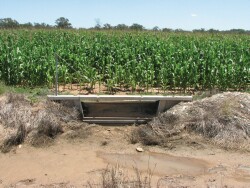 High flow Padman bay outlet |
Mark finds ease of management to be a significant benefit when compared to the lower flows historically applied. Irrigating is quicker because it is more intense, but doesn’t take as long, freeing up time for other activities. Mark’s general rule of thumb is that it takes about 1 to 1.5 hours per hectare to irrigate, depending on the fall on the bay, the percentage of crop cover and the temperature.
The design of the gates also allows anyone to open and close them with ease, so the work is not as physically challenging.
It’s possible to irrigate more than one bay at a time, which can sometimes be advantageous but obviously reduces the flow rate onto each bay and therefore reduces some of the benefits derived from irrigating faster.
Mark and Monique normally sow their annual pasture early, in March, which can be a risk if the weather then becomes hot. They have noticed even if they do experience hot days, they get less scalding of the pasture because there’s not as much ponded water on the bay for as long. They also notice fewer water weeds in the pasture because the water gets on and off quickly. As their water supply is pumped, another benefit of shorter irrigation times is reduced pump running time, which reduces their power costs.
How much did it cost?
For the Bryants, installing larger irrigation outlets has cost $550 per outlet ($450 for each outlet and $100 per outlet to install). If other works such as landforming and channel remodelling were performed, the outlets would not represent a large percentage of the total cost.
Did the benefits outweigh the cost?
The Bryants believe they recovered some of their costs in the first watering. Temporary water was expensive at the time and they halved their water use, saving approximately 6 ML which could be used elsewhere on the farm, or traded.
Is there anything to look out for?
“With faster flow rates, if you get the irrigation shut off time wrong it can be a big mistake and results in a bit of a mess. If you were 30 minutes late using 6 ML/d it’s not a big issue, but being 30 minutes late using 15 ML/d is a big mistake.”
“It’s more intense while you’re irrigating so you’re busier chasing water but the flip side of this is you spend less time irrigating.”
Getting enough water out of your irrigation supply system could be a problem. The Bryants have a pumped supply with an adequate flow rate, but others should make sure their meter, supply channel and on-farm channels can deliver the required flow rate.
Make sure checkbanks are adequate. With a heavy crop such as rye in full production the amount of water it holds up is significant and this can result in water spilling onto adjacent bays. Shut off time should be adhered to in this situation because the water is there, it just takes a bit longer to get through the crop. Mark shut off late once because the water hadn’t gone as far down the bay as expected, but this just resulted in lots of water going off the end of the bay. It is important to have good drainage to get the water off and away from the bay, and to have an effective re-use system with sufficient capacity for those potentially larger drainage flows.
Research
How surface irrigations behave is strongly influenced by the rate water infiltrates into the soil. Infiltration is in turn influenced by the soil type and the dryness of the soil. Figure 1 (Bethune, 2004) shows cumulative infiltration curves for a typical light levee soil, such as the East Shepparton fine sandy loam on the Bryant’s farm, and a typical heavy floodplain soil from the Goulburn Murray Irrigation District. Both soil types have a high initial rate of infiltration that reduces over time to a constant rate, termed the final infiltration rate.
In the case of the heavy floodplain soil of Figure 1, the initial infiltration rate is very high because these soils crack on drying. Initial infiltration is dominated by crack filling, which is almost instantaneous. Once cracks have filled however, infiltration slows dramatically. On these soils expect water savings to be limited, due to faster surface irrigation and reduced deep drainage.
It’s a different story on lighter soils such as East Shepparton fine sandy loam. Here, cracks usually play a lesser role, so the initial infiltration rate can be less than floodplain soils, but the lighter texture of these soils leads to much higher final infiltration rates. On these soils a reduction in ‘opportunity time’ – the time that water is ponded on the surface of the irrigation bay – can make a big difference to the amount of water that infiltrates below the crop rootzone.
| Mehta and Wang (2005) reported final infiltration rates for Lemnos loam, a medium textured floodplain soil common in the Shepparton Irrigation Region, of between 0.2 and 4.9 mm/hr, averaging 1.4 mm/hr. In contrast, final infiltration rates for East Shepparton fine sandy loam soil profiles were up to 33.8 mm/hr, with an average of 10.3 mm/hr.
Further information
| 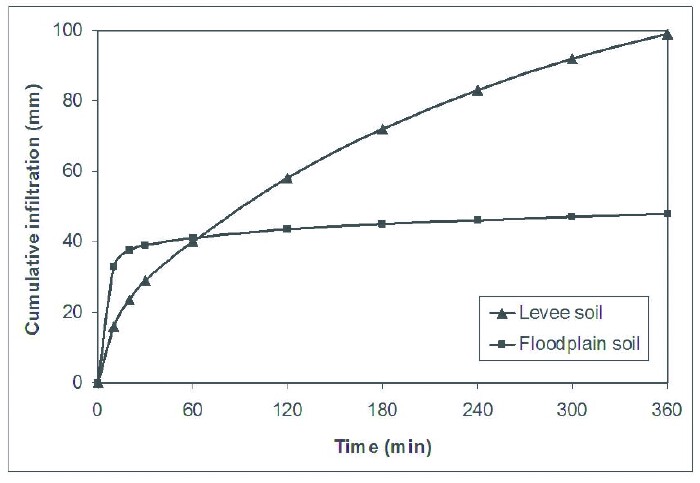 Figure 1. Typical infiltration curves for levee (light) and floodplain (medium to heavy) soils |
..................................................................................... |
Higher Flow Rate Irrigation - Medium Soil
Who: Mark and Lynne Peterson
Where: Nathalia
Enterprise: Dairy
What: Larger Flow Rate Bay Outlets
On the farm
Background
Mark and Lynne Peterson are currently milking 130 cows and increasing their herd on a 180 hectare property, northeast of Nathalia. Mark’s father bought the farm in 1976 and it has been a dairy enterprise since then. Mark completed his apprenticeship on the property in the early 1980s. Mark and Lynne took over full control of the property in 2000. The farm practices biodynamic agriculture and has done so since 1987.
Nine bays (approximately 300 m long and 45 m wide) and the channel supplying them were remodelled in February/March 2010 to receive flow rates of up to 20 ML/d. 600 mm piped Padman outlets 2.4 m long were installed. The bays were sown to permanent pasture in autumn 2010. The current supply system can only deliver a maximum of 10 ML/d to these bays. Modernisation of the supply system will result in the property being connected to a 20 ML/d supply.
A mixture of soil types are present across the farm, however the bays set up for fast flow contain mostly medium clay loam soil. The Petersons aim to use approximately 0.5 ML/ha per irrigation. Their High Reliability Water Share is 290 ML and they plan to supplement this with temporary water in the medium term, unless the price of permanent water falls. A Whole Farm Plan has been developed for the property and production is focussed on the most suitable soils.
Mark believes there is merit in irrigating with higher flow rates and the cost difference to install larger outlets as a component of the required channel upgrade, was minimal. If he is wrong and the flow rate is too high for his soils, he can irrigate two bays at a time and still reduce the time he spends managing irrigations.
| The benefits according to Mark
It’s too soon for the Petersons to know the production and water use benefits of their new system, as the large outlets have only been used a few times and flow rates are currently restricted to 10 ML/d. However, Mark feels that less water is being used per irrigation. The main benefit identified so far, has been the ease of irrigating. Being able to deliver 10 ML/d to the bays has reduced the time taken to irrigate and ensured the irrigation time is fairly consistent. The outlets installed can be automated which is a great advantage. Bay slopes range from 1:850 to 1:1,000, which is relatively flat for permanent pasture, so being able to irrigate faster should help to get water on and off the bays more quickly. It is currently taking about 2.5 to 3 hours to irrigate each bay. How much did it cost? For the Petersons the cost has been minimal – they were refurbishing the farm channel anyway, so the cost of adopting a higher flow rate amounted to the difference in cost between smaller outlets and the larger ones they have used. | 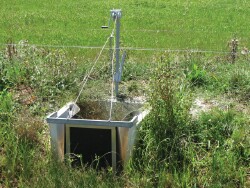 High flow piped Padman bay outlet |
Did the benefits outweigh the cost?
Mark’s gut feel is that the benefits will outweigh costs for a range of reasons, such as improved pasture quality, convenience and ease of irrigating, easier channel maintenance, and likely improvements to water use efficiency. But does fast flow work? Mark is not sure at this early stage.
Is there anything to look out for?
Mark is still learning how to drive the system, but drainage off the bottom and away from the bays is critical. “If you don’t get the time to shut off irrigation there will be water everywhere.”
Research
On a medium-heavy clay loam, Mark may not see the water savings that irrigators on light soils would (see Higher Flow Rate Irrigation - Light Soil) and may find the ‘opportunity time’, or time that water is ponded on the bay, is insufficient at high flow rates to adequately replenish soil moisture. As Mark says, he does have the option of slowing down irrigations by irrigating two bays at a time if this is the case.
The cost of implementing higher flow rate irrigation seems to have been small in Mark and Lynne’s case, since they were redeveloping anyway. Even if water savings are minimal, there are other benefits they can capture. One of the nice aspects of their development plan is the opportunity they have to test fast flow on part of their farm, learning how it can work for them, without major financial risk.
On relatively flat bays, such as those on Mark and Lynne’s farm, a low irrigation supply flow rate and slow water advance down bays can cause excessive opportunity time and over-watering at the top of the bay, and/or little or no opportunity time and under-watering at the bottom of the bay. In these cases, a higher flow rate can increase irrigation uniformity.
Higher flow rate irrigation should reduce production losses due to scalding and waterlogging, provided surface drainage is able to quickly remove excess water from the bottom of bays. On Mark’s relatively flat bays, spinner cuts will help remove excess water from the bottoms of bays more quickly.
With shorter irrigations, Mark should spend less time chasing water, and the outlets he has installed provide him with the option to automate later and further reduce the time he spends managing water. High flows do require more careful management of cut-off though. As Mark says, a timing mistake at a low flow rate will not matter too much, whereas a late cut-off at high flows will result in ‘water everywhere’. This underscores the need for good surface drainage and an adequate reuse system able to handle the higher drainage flows that can occur with high flow irrigation.
 High flow piped Padman bay outlet | 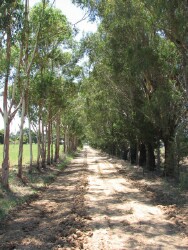 Tree lined farm track |
Further information
- Talk to Rob O’Connor at DPI Echuca on 03 5482 1922.
- Information notes – go to www.dpi.vic.gov.au
- Talk to bay outlet manufacturers or an irrigation surveyor and designer. It is also a good idea to talk to other farmers who have implemented this change in your local area.
- Consider enrolling in an irrigation and risk management course. More information can be obtained from Rob O’Connor at DPI Echuca on 03 5482 1922.
- Murray Dairy started some trials (10/11 irrigation season) to test some higher flow rates on various soil types. When available, the findings from these trials may be useful to irrigators.
..................................................................................... |
Sub-surface Drop Irrigation of Lucerne
Who: Brett Dixon
Where: Merrigum
Enterprise: Dairy
What: Sub-surface Drip Irrigation
On the farm
Background
Brett Dixon works a dairy farm east of Merrigum that has been in the family since 1975, when it was purchased by his father. Brett has worked on the farm since 1986 and with a succession plan in place will take full control of the operation this year.
The property is 800 hectares in total and the Dixons aim to irrigate most of this each year (excluding a small non-commanded section). The bulk of the property is sown to annuals, with approximately 162 hectares at the home farm sown to perennials and 22 hectares of a 60 hectare, unlasered out-block under subsurface drip irrigation (SDI) and sown to lucerne.
When the operation is at its peak, 620 cows are milked.
The home farm soils are predominantly Shepparton fine sandy loam with some Lemnos loam. The out-block where the SDI system is installed is predominantly Lemnos loam soil.
Low water allocations drove the Dixons to consider ways to reduce their water use whilst maintaining or improving forage production.
What was done?
The Dixons looked at a number of options for increasing production while using less water, including centre pivot and lateral move systems, but weren’t convinced these systems could deliver greater production with less water use when compared to SDI. In addition, the out-block shape was not suited to centre pivot systems, being 1.6 kilometres long and only 400 m wide.
A SDI system was installed on 22 ha and sown to lucerne in September 2007.
Before committing to the purchase, the Dixons spoke to tomato growers, Netafim, and Danny Bergamin (a local dairy farmer that has been growing lucerne with a SDI system for some time) to learn about the technology.
The benefits according to Brett
Brett identified three main benefits of the system:
- Higher production compared to conventional surface irrigation (Brett estimates 23-24 t/ha). He finds he has greater control over irrigation so he’s not alternately waterlogging and then drought stressing the crop, as occurs with surface irrigation – SDI provides a more constant moisture regime. In addition, the Dixons can irrigate quickly after cutting which gets the plant going sooner, allowing an additional cut per year.
- More effective water use — the application of irrigation water is not open to the air, therefore there is less evaporation. In addition, they can match the water application to the plant’s requirements.
- Decreased labour input — the out-block where the SDI system is installed is about 5 kilometres from the home farm and if the surface was irrigated would need much greater hands-on management. With the automated SDI system they can control it remotely and there is less need to be checking it, saving considerable time.
“When we installed the system we only needed a 10% allocation of water to be able to water the 22 hectare block (the SDI block). We know what it costs us to grow, cut, bale and cart it. We aim to get 600-700 tonnes off that block (hay and/or silage). We have been getting 23-24 tonnes/ha (approximately 520 tonnes off 22 hectares).” |
Brett believes they are using 7-8 ML/ha (of irrigation water without rainfall). They don’t have a flow meter on the system and can’t measure it, so Brett bases this estimate on the amount Danny Bergamin receives.
How much did it cost?
It cost the Dixons $8,000 per hectare for pumps, pipes and equipment. Power connection was an additional $16,000 which might not be required on some properties. There were some earthworks required and the lucerne sowing costs (fertiliser, seed, etc). All up it cost the Dixons approximately $250,000 ($11,360/ha).
Did the benefits outweigh the cost?
The Dixons believe so — the cost of bought in feed was significant in the first two years of operation (2007/08 and 2008/09).
Compared to other systems, the ease of irrigating reduced the labour component which saved both time and money. The Dixons don’t have to be closely managing irrigations as they would with other systems. Being on an out-block away from the home farm, the time saved has been significant.
Is there anything to look out for?
Brett believes you only get one go at getting it right, so don’t take short cuts – do it properly. It’s not like lasering or above ground technologies where you can go back and touch it up or easily modify it. It would be a negative experience if the system was not designed and installed properly because it would not deliver the benefits.
Brett would also advise others to consider putting in a flow meter – it’s an extra cost but it would be good to know what the water use is.
“People sometimes try to use old tomato systems to grow lucerne but these are not designed for it, Ray Sellwood does it pretty well but he’s probably an exception. Old tomato beds are hard on machinery as well.” |
The Dixon’s system is on an unlasered block so some areas get a bit wet with significant rainfall. Lucerne doesn’t like being wet and there are some patches Brett considers to look a bit ordinary. Although it looks bad, he doesn’t believe it equates to a massive reduction in production across the paddock. In fact Brett believes the production is higher than would be achieved using alternative irrigation methods.
Research
Pressurised irrigation systems such as SDI typically feature relatively large, upfront capital costs. They can however provide a good return on investment over time, provided they produce more fodder with a high value and/or save on high value inputs such as labour and water.
| In the Dixon’s case, their out-block was not landformed and needed development in order to be productive. By opting for a SDI system, they have saved the cost of landforming and earthworks that would have been associated with establishing a surface irrigation system. The out-block is remote from their home farm, so the savings in time and labour associated with managing an automated SDI system have also been significant. Finally, their out-block is an awkward shape, which a SDI system could irrigate more effectively than either surface or spray systems. This means they could have a greater proportion of the developed area under production, and productive for more of the time.
SDI seems to have met all their requirements. It has enabled them to maximise the area of the out-block under production and minimised their labour costs. They believe they are saving water, but without a meter on the pump there is a bit of guesswork in this, although water savings would be expected. An experiment at Tatura comparing SDI with other irrigation systems for perennial pasture production used 2 ML/ha/yr less than surface irrigation, with much greater control over the amount of water applied, and achieved 10% more pasture production. | 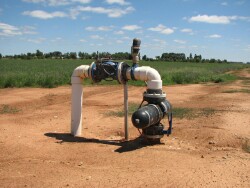 In field secondary filter and control valve |
What has made the Dixon’s adoption of SDI so attractive, however, has a lot to do with timing. They had the system in place and efficiently producing good quality fodder at a time when bought-in fodder costs were very high, water was scarce and expensive, and milk prices were high. The Dixons clearly did their homework prior to committing to the investment, consulting widely with other farmers experienced with the technology, as well as service providers.
To get the most from their system, installation of a flow meter is recommended so they will know how much water they are applying. Use of soil moisture probes to assist with irrigation timing and indicate how much water to apply would also be valuable for saving water in dry years, as well as saving crops under wetter conditions.
Compared with alternative development options the Dixons could have pursued at the time, their investment in SDI has proved to be a good one, providing their dairy operation with an effective fodder strategy during dry conditions. Under different circumstances it might not look so positive though. As with any major investment, risks will be reduced with a thorough financial analysis that assesses potential development options with respect to farm business circumstances, management capacity, attitude to risk and likely future scenarios with respect to prices and costs.
Further information
- Talk to Rob O’Connor at DPI Echuca on 03 5482 1922.
- Talk to manufacturers of the technology or an irrigation surveyor and designer.
- It is also a good idea to talk to other farmers who have implemented this change in your local area.
- Consider enrolling in an irrigation and risk management course. More information can be obtained from DPI Echuca on 03 5482 1922.
References
Higher Flow Rate Irrigation - Light Soil
Figure 1. Bethune, M., 2004. Towards effective control of deep drainage under border-check irrigated pasture in the Murray Darling Basin: a review. Australian Journal of Agricultural Research, 55(5), pp.485-494.
Metha, Brijesh and QJ Wang. 2005. Soil Hydraulic Properties of the Shepparton Irrigation Region, Department of Primary Industries, Tatura. http://www.dpi.vic.gov.au/dpi/vro/gbbregn.nsf/pages/soil_hydraulic


